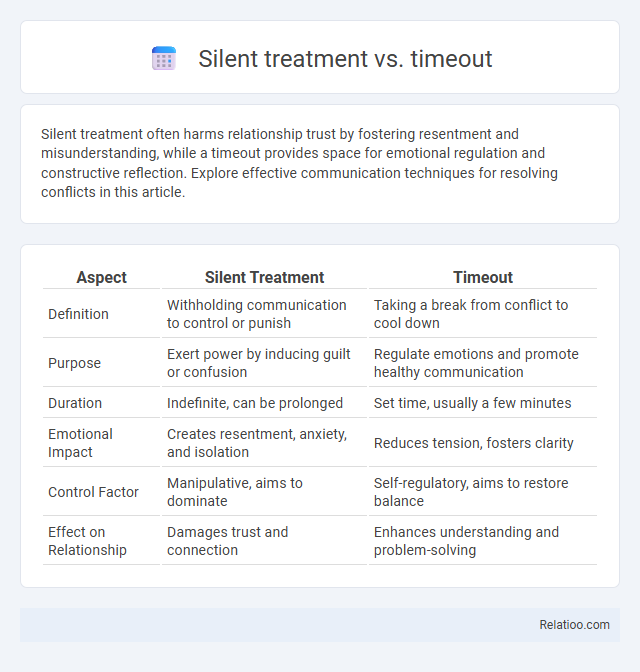Silent treatment often harms relationship trust by fostering resentment and misunderstanding, while a timeout provides space for emotional regulation and constructive reflection. Explore effective communication techniques for resolving conflicts in this article.
Table of Comparison
| Aspect | Silent Treatment | Timeout |
|---|---|---|
| Definition | Withholding communication to control or punish | Taking a break from conflict to cool down |
| Purpose | Exert power by inducing guilt or confusion | Regulate emotions and promote healthy communication |
| Duration | Indefinite, can be prolonged | Set time, usually a few minutes |
| Emotional Impact | Creates resentment, anxiety, and isolation | Reduces tension, fosters clarity |
| Control Factor | Manipulative, aims to dominate | Self-regulatory, aims to restore balance |
| Effect on Relationship | Damages trust and connection | Enhances understanding and problem-solving |
Understanding the Silent Treatment
The silent treatment involves deliberately ignoring or refusing to communicate with someone as a form of punishment or control, which can damage trust and emotional connection in relationships. In contrast, a timeout is a conscious, temporary break taken by one or both parties to cool down and prevent escalation, promoting healthier conflict resolution. Understanding the silent treatment is crucial to recognizing its emotional impact on you and addressing communication breakdowns effectively.
What Is a Timeout in Communication?
A timeout in communication is a deliberate, temporary pause used to prevent escalation during conflicts by allowing both parties to cool down and reflect before continuing the discussion. Unlike the silent treatment, which involves withholding communication to punish or manipulate, a timeout prioritizes mutual respect and emotional regulation. Incorporating timeouts effectively can improve your conflict resolution skills by fostering clarity and preventing misunderstandings.
Psychological Impact of the Silent Treatment
The silent treatment, unlike a timeout, is a passive-aggressive tactic that can cause significant emotional distress, leading to feelings of rejection and decreased self-esteem. Timeouts, often used as a tool for conflict resolution or emotional regulation, provide space for reflection without emotional harm. Your mental health can suffer from the silent treatment's psychological impact, as it may trigger anxiety and foster unresolved conflicts, hindering effective communication and relationship growth.
Emotional Effects of a Timeout
Timeouts provide a structured break that allows individuals to calm down and gain perspective, reducing emotional intensity and promoting self-regulation. Unlike the silent treatment, which often fosters feelings of rejection and resentment, timeouts encourage reflection without damaging relational trust. Emotional effects of a timeout include decreased stress and improved emotional clarity, facilitating healthier communication and conflict resolution.
Key Differences: Silent Treatment vs Timeout
The silent treatment involves deliberately ignoring or refusing to communicate, often used as an emotional punishment, whereas a timeout is a structured disciplinary tool designed to give individuals time to calm down and reflect on their behavior. Silent treatment typically escalates conflict by fostering resentment and emotional distance, while timeout aims to de-escalate tension and promote self-regulation. Unlike silent treatment, timeout is time-limited and intended to be a constructive intervention rather than a method of emotional control.
Intentions Behind Each Approach
The silent treatment typically aims to punish or express displeasure by deliberately withholding communication and emotional connection, leading to feelings of isolation in the recipient. In contrast, a timeout is a purposeful pause used to cool down, reflect, and prevent escalation during conflicts, promoting emotional regulation rather than punishment. Comparing silent treatment vs timeout, the key distinction lies in intention: silent treatment often seeks control or retribution, whereas timeouts prioritize constructive conflict resolution and self-soothing.
Healthy Conflict Resolution Strategies
Timeout provides a structured break to cool down and reflect, promoting constructive dialogue once emotions settle. Silent treatment, often passive-aggressive, can escalate misunderstandings and hinder resolution by avoiding communication. Your focus on healthy conflict resolution should prioritize open, respectful communication and strategic timeouts to prevent resentment and foster mutual understanding.
When Silent Treatment Becomes Harmful
Silent treatment becomes harmful when it is used as a tool for emotional manipulation rather than a means to cool down during conflicts, causing feelings of abandonment and anxiety. Unlike timeouts, which are intentional breaks aimed at de-escalating tension and promoting healthy communication, prolonged silence in silent treatment creates a barrier to resolving issues. Consistent use of silent treatment leads to eroded trust and increased emotional distance, damaging relationships in both personal and professional contexts.
Benefits of a Timeout in Relationships
Timeouts in relationships provide a structured pause for emotional regulation, reducing the risk of impulsive reactions and escalating conflicts. This intentional break fosters self-reflection and clarity, allowing partners to process feelings independently before reconvening for constructive dialogue. Unlike silent treatment, which can breed resentment, timeouts encourage healthy communication and emotional resilience.
Choosing Constructive Communication Techniques
Choosing constructive communication techniques is essential for fostering healthy relationships and resolving conflicts effectively. The silent treatment often escalates misunderstandings by creating emotional distance, while a timeout offers a purposeful pause for self-reflection and calming down before addressing issues. Your ability to use timeouts strategically encourages productive dialogue and emotional regulation, leading to clearer understanding and stronger connections.

Infographic: Silent treatment vs Timeout
 relatioo.com
relatioo.com